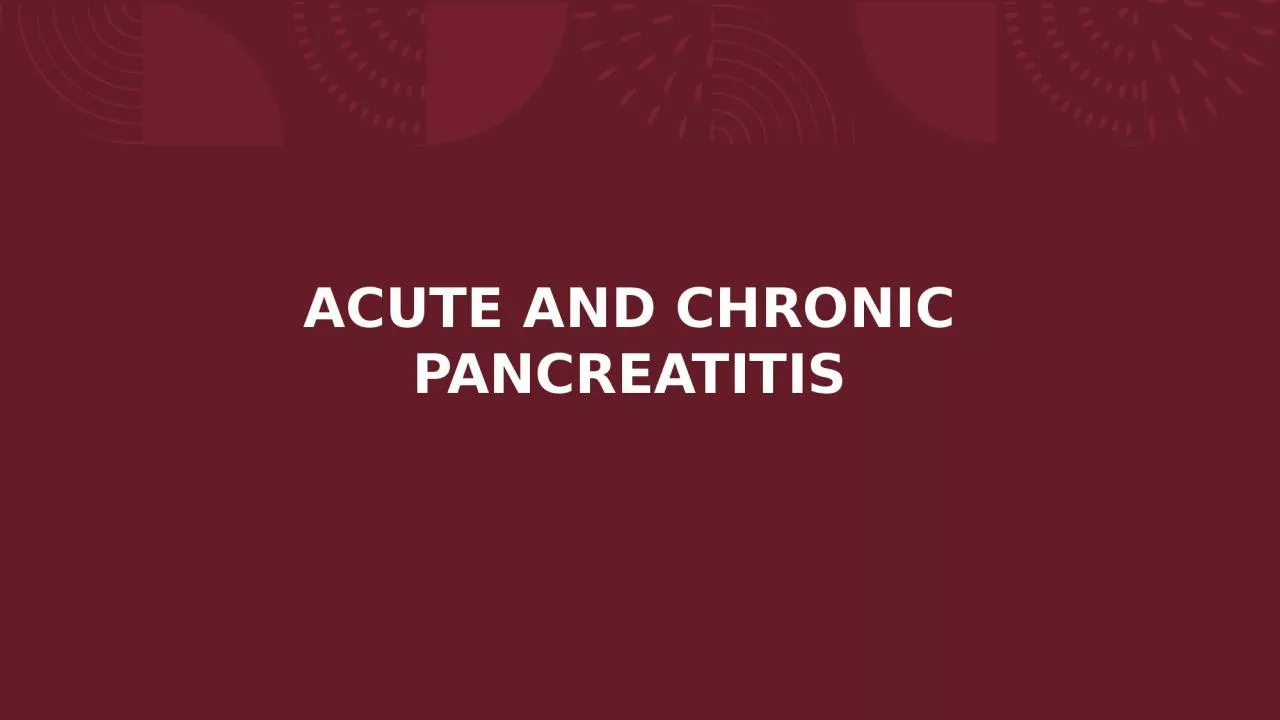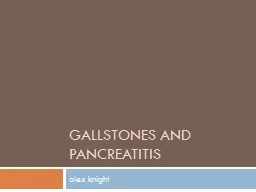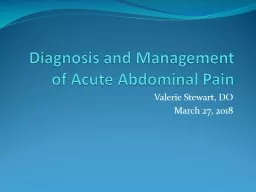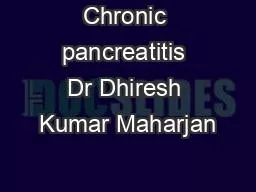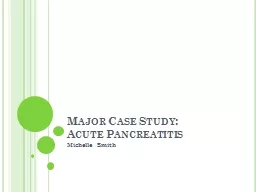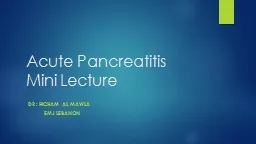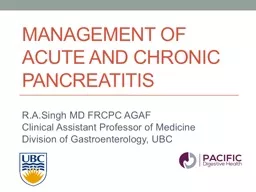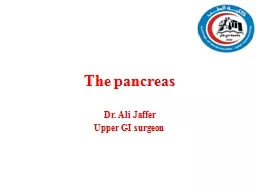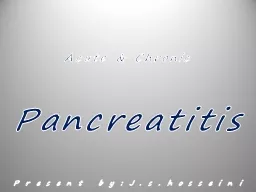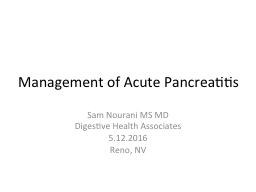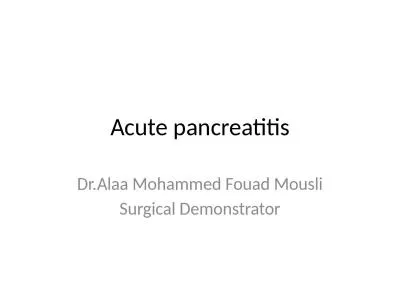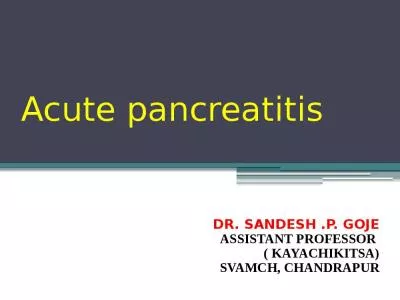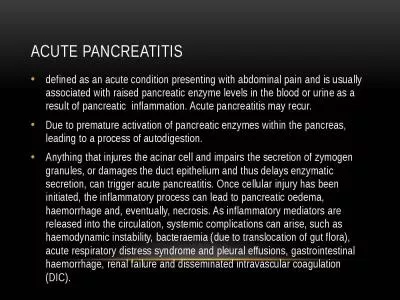PPT-ACUTE AND CHRONIC PANCREATITIS
Author : WonderWoman | Published Date : 2022-07-28
ACUTE PANCREATITIS Acute pancreatitis accounts for 3 of all cases of abdominal pain admitted to hospital It is a potentially serious condition with an overall mortality
Presentation Embed Code
Download Presentation
Download Presentation The PPT/PDF document "ACUTE AND CHRONIC PANCREATITIS" is the property of its rightful owner. Permission is granted to download and print the materials on this website for personal, non-commercial use only, and to display it on your personal computer provided you do not modify the materials and that you retain all copyright notices contained in the materials. By downloading content from our website, you accept the terms of this agreement.
ACUTE AND CHRONIC PANCREATITIS: Transcript
ACUTE PANCREATITIS Acute pancreatitis accounts for 3 of all cases of abdominal pain admitted to hospital It is a potentially serious condition with an overall mortality of 10 About 80 of all cases are mild and have a favourable outcome. Directed Readings . In the Classroom. July/August . 2012 issue of . Radiologic Technology. .. Instructions:. This presentation provides a framework for educators and students to use Directed Reading content published in . a. lex. knight. Topics. Case Presentation. Bile and LFT’s. Gallstones. Risk Factors. Complications + Presentations. Clinical Scenario. A 45 year old female presents to A&E with an hour long history of severe RUQ pain, and associated vomiting. . Valerie Stewart, DO. Clearwater Surgical Associates. March 27, 2018. Objectives. Describe types of acute abdominal pain . Describe common causes of acute abdominal pain. Describe appropriate diagnostic workup of common causes of acute abdominal pain. Cedar Mountain post acute rehabilitation center provide a therapeutic environment for our residents Yucaipa. Individualized treatment programs are developed with the interdisciplinary team of nursing, social services, Healthcare and dietary in consultation with your physicians. 16. th. June 2020. Chronic pancreatitis. Definition:. Pathophysiology:. Diagnosis:. Treatment:. Definitio. n. Chronic . pancreatitis (CP) is a progressive irreversible . inflammatory disease . where pancreatic parenchyma is . Michelle Smith. Outline. Introduction. Social & P. ast Medical History. Normal Anatomy & Physiology. Disease Condition . Lab Findings & Medications. Treatment. Past & Current Nutrition of Patient. DR : HICHAM AL MAWLA . . . emj. . lebanon. Establish the . Diagnosis. of Acute Pancreatitis. Establish the . Etiology. of Acute Pancreatitis. Initial . Management. of Acute Pancreatitis. R.A.Singh. MD FRCPC AGAF. Clinical Assistant Professor of Medicine. Division of Gastroenterology, UBC. Disclosures. Speaker honorarium from: Takeda. . . . Upper GI surgeon. Anatomy. The pancreas is situated in the . retroperitoneum. . . It is . divided into a head, which occupies 30% of the gland . by mass. , and a body and tail, which together constitute 70. Present . by:J.s.hosseini. Anatomy. Retroperitoneal Organ . Weighs 75 To 100 G . 15 To 20 Cm Long. Head. Neck. Body. Tail. . 2. . Inflammation . or infection of the . pancreas. Normally . digestive enzymes secreted by the pancreas are not . Sam Nourani MS MD. Digestive Health Associates. 5.12.2016. Reno, NV. Acute Pancreatitis. Acute inflammatory process of the Pancreas. Mortality ranges:. 3% for interstitial edematous pancreatitis. 17% for pancreatic necrosis. Mohammed . Fouad. . Mousli. Surgical Demonstrator. Acute pancreatitis. INTRODUCTION . :. Acute pancreatitis is an acute inflammatory process of the pancreas. It is usually associated with severe acute upper abdominal pain and elevated blood levels of pancreatic enzymes. Most cases are associated with alcoholism or gallstones, but the precise . DR. SANDESH .P. GOJE. . ASSISTANT PROFESSOR . ( KAYACHIKITSA). SVAMCH, CHANDRAPUR. Inflamed pancreas. Acute pancreatitis . Introduction and definition . Acute pancreatitis is a sudden . inflammation. Due to premature activation of pancreatic enzymes within the pancreas, leading to a process of . autodigestion. . . Anything that injures the . acinar. cell and impairs the secretion of zymogen granules, or damages the duct epithelium and thus delays enzymatic secretion, can trigger acute pancreatitis. Once cellular injury has been initiated, the inflammatory process can lead to pancreatic .
Download Document
Here is the link to download the presentation.
"ACUTE AND CHRONIC PANCREATITIS"The content belongs to its owner. You may download and print it for personal use, without modification, and keep all copyright notices. By downloading, you agree to these terms.
Related Documents

